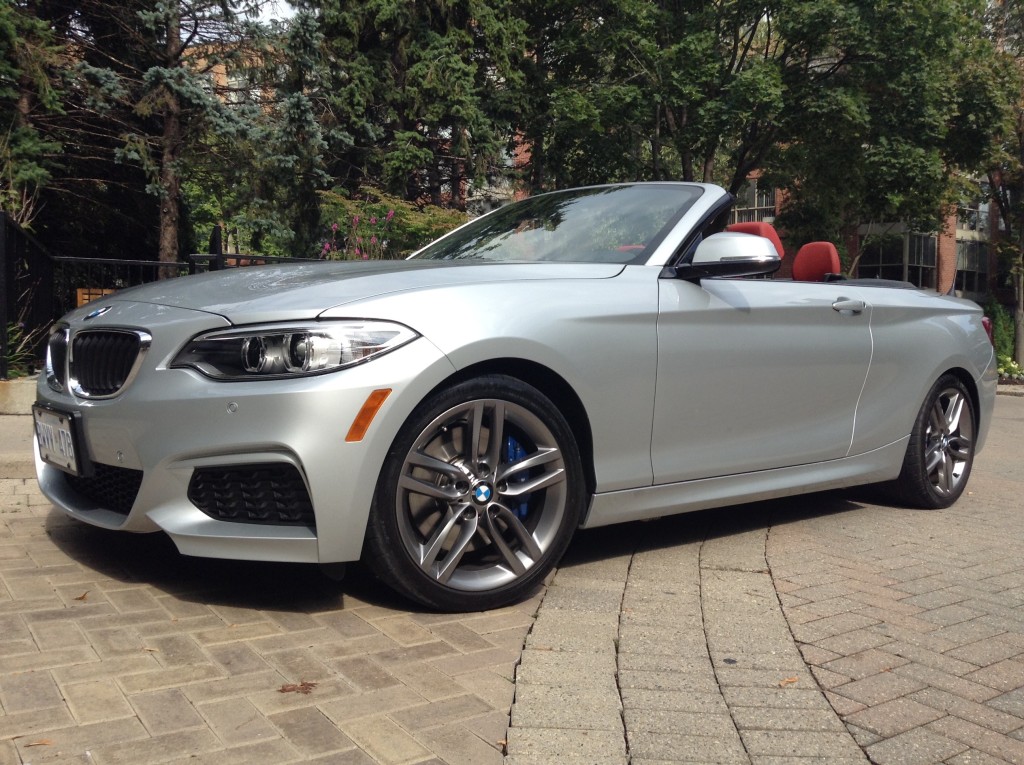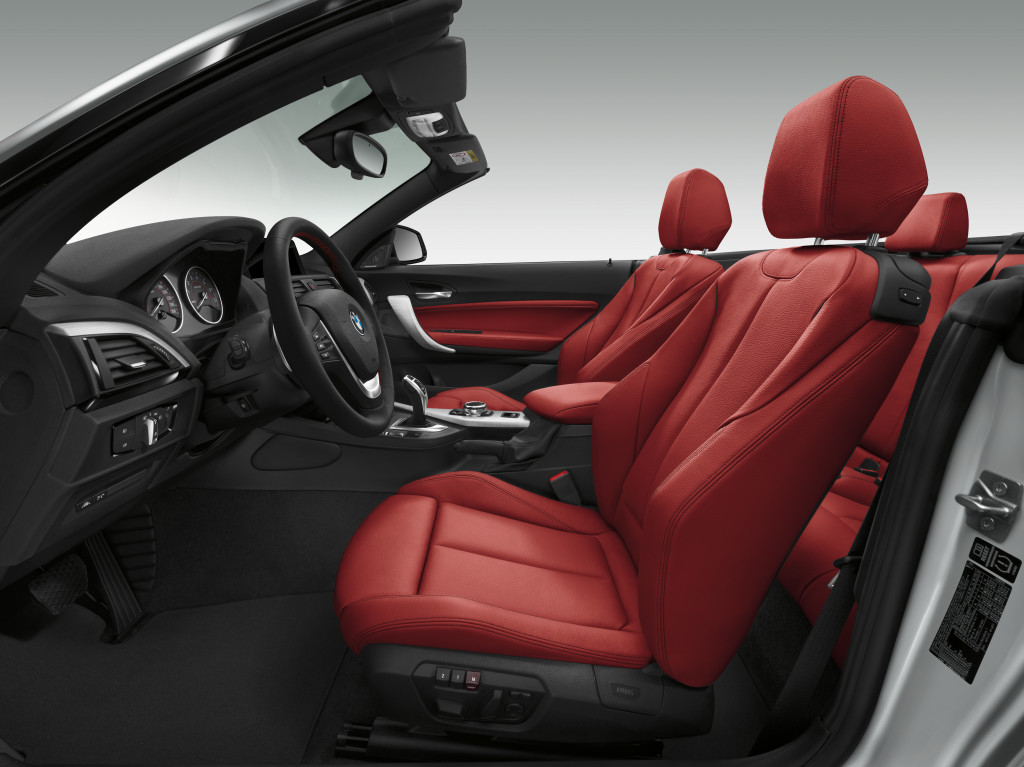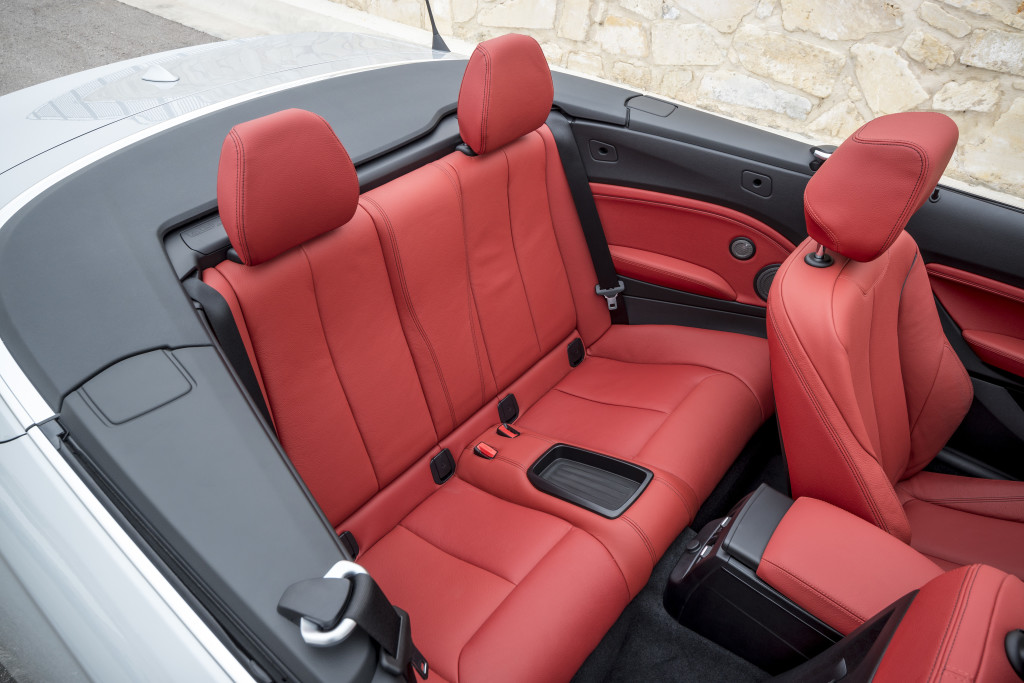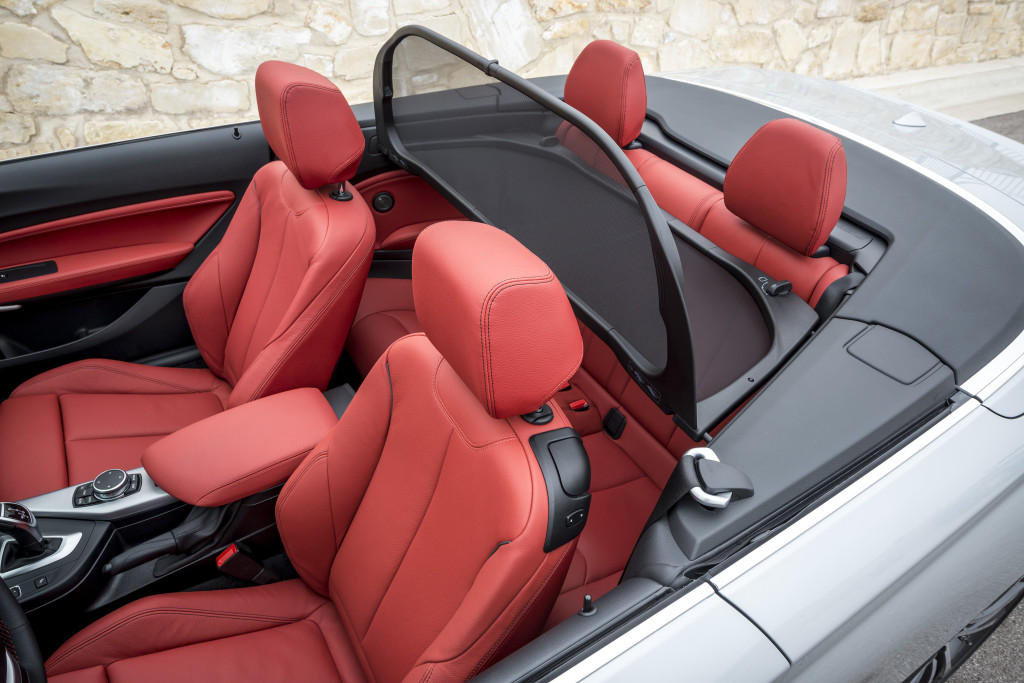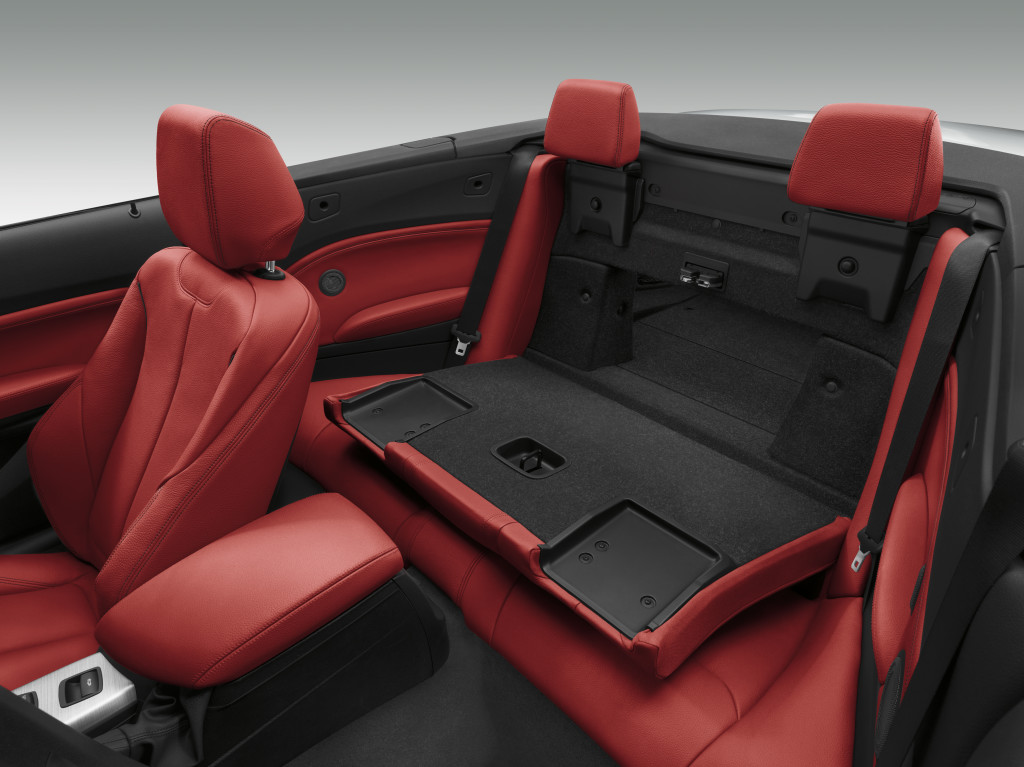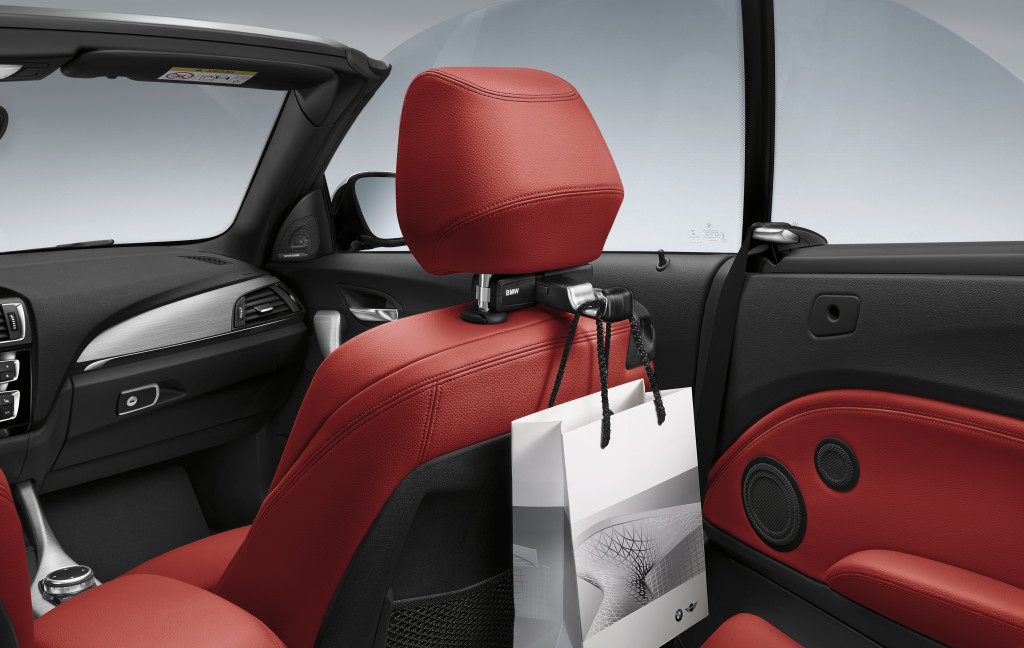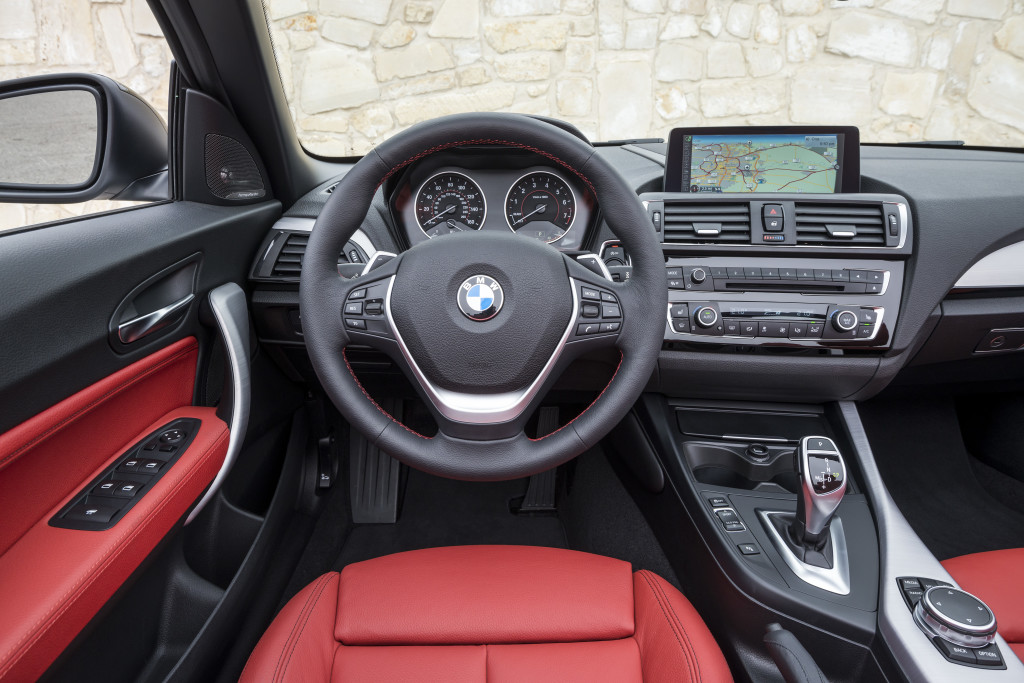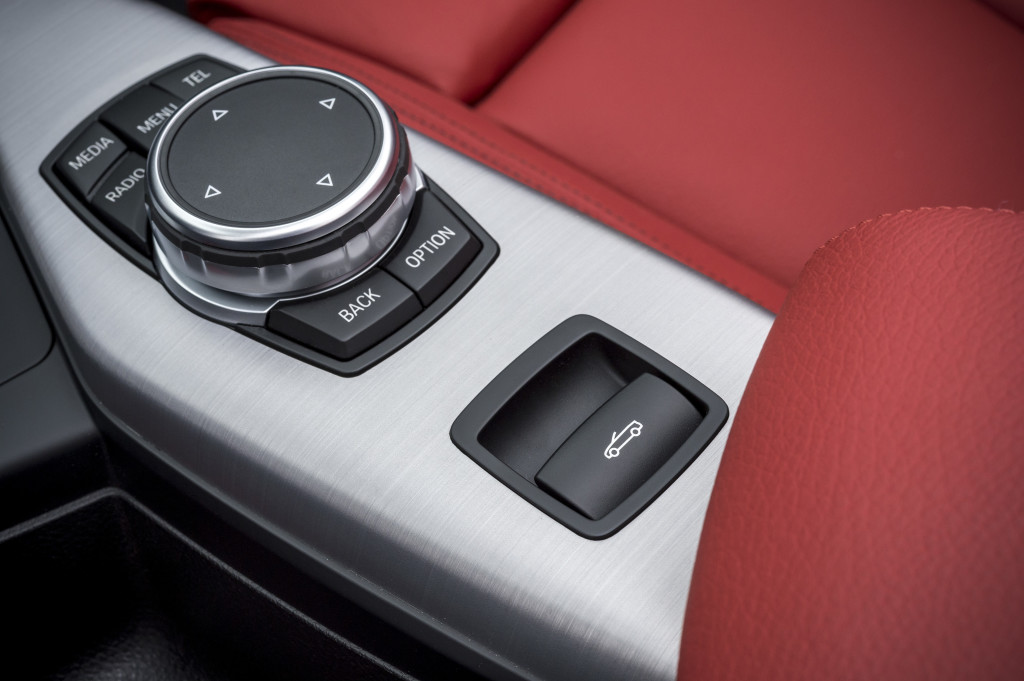When carmakers build facilities on large plots of land, they like the roads that lead to their facilities to bear their company names.
BMW goes one better. Their offices north of Toronto aren’t located on “BMW Avenue.” They’re on – wait for it – Ultimate Drive. That’s an auspicious name for any auto journalist who visits, as I did in August to drive away in the 2015 228i xDrive Cabriolet.
Both the 228i and its 2-class sibling, the M235i, came to the market in 2014. BMW refreshed both for the 2015 model year.
First impressions
The standard twin kidneys grill sit above the bumper. Underneath, air curtains integrated into the front fascia channel onrushing air behind the front fenders, reducing turbulence in the wheel arches. A close look at this part of the car may make racing fans see the shape of the “wings” at the front of Formula One cars.
The front of the car leads to subtle, muscular lines that run the length of the vehicle. They contribute to the “forward-surging urgency” (BMW’s well-chosen words) design that the Bavarian carmaker imbues on each car in its fleet.
The only thing that seemed out of place was the soft top, but I would take care of that in short order.
Opening the doors, one sees some “M” badging on the aluminum door sill strip (which sits under the door when it’s closed). It’s part of the “M Sport Line” option ($2,000) which includes:
- 18” M Light Alloy Ferric Grey Double-spoke wheels w/Performance non-runflat tires
- Sport Seats
- M Leather Steering Wheel
- M Aerodynamics Package
- Brushed Aluminum Trim
- High-gloss Shadow Line
The “M” also adorned the driver’s footrest and the blue disc brake calipers on all four wheels.
Interior
Coral Red Dakota Leather seats and accents strike the eye first. They’re a great contrast to the aluminum trim in the cabin and the car’s Glacier Silver Metallic paint job.
Sitting in the car, my first impression was that a giant parked it in BMW’s lot. I couldn’t initially reach the pedals, an experience few people of my stature (I’m 6’5″) can relate to.
Second impression: in addition to the power seat controls and memory settings on the side of the seat, the front of the seat extends forward several inches to support more of the driver’s thighs.
The beefy leather heated steering wheel feels solid to the touch.
Finally, I realized how low-slung this convertible happens to be. It feels like a sports car before it even moves
Once I got comfortable, I took in subtler details.
BMW put the door lock button in the middle of the car, just below the hazard warning flasher button instead of on the driver’s door, so both the front seat passenger and the driver can easily reach it.
Dual climate controls keep driver and front-seat passenger comfortable. Vents at the rear of the centre armrest keep backseat passengers comfortable. Not that the back seat was my cup of tea.
It isn’t as cramped as other back seats I’ve seen, but it won’t likely accommodate taller-than-average passengers.
The removable windscreen that reduces gusts in the cabin anchors over the rear seats.
Cargo capacity
I had to jimmy my hockey bag into the trunk several times (I play twice a week, even in the summer). The trunk opening is not large, since the taillights stretch far across the back of the car. BMW kept the taillights entirely on the rear quarter panel instead of splitting the lights between the panel and the trunk lid as they do on other models.
Tip: If you want to cruise to your hockey game with your equipment in the trunk and the top down (and what right-thinking Canadian hockey player doesn’t?) put the top down first, then put the bag into the trunk.
With the top up, you can fold up the partition that separates the ragtop storage compartment to obtain extra trunk space.
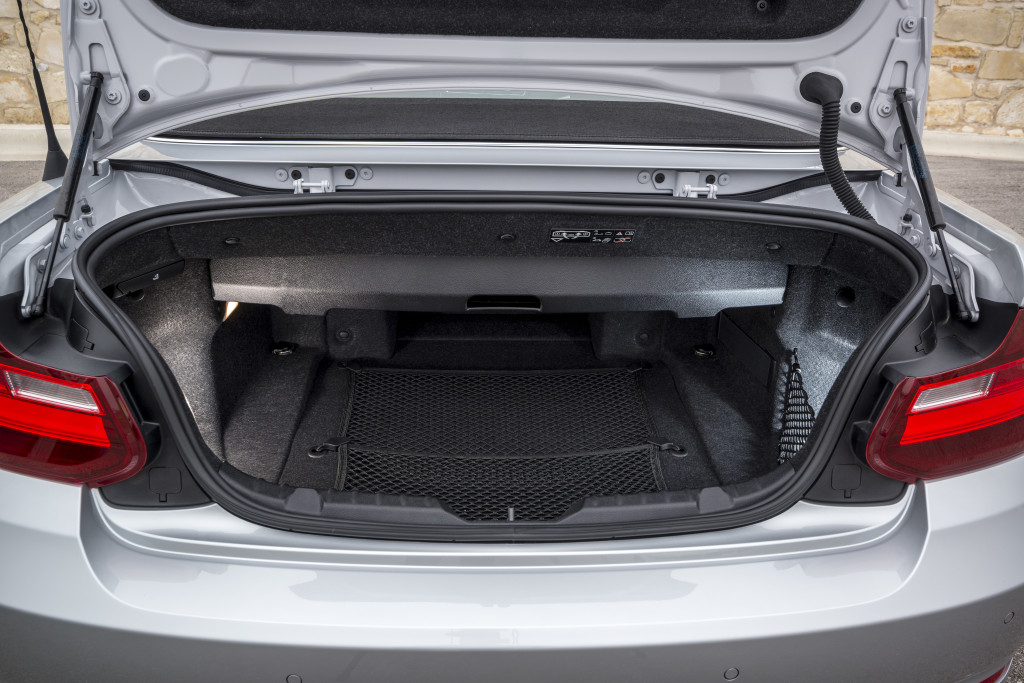
You can see the fold-up partition just under the rear deck lid. It has “handles” near the ends. Photo courtesy BMW Group
When I put my bag in the 228i with the top up, I inadvertently shoved this partition up. The car wouldn’t let me put the cover down until I got out of the car, took my bag out of the trunk, pulled the compartment down and closed the trunk. I could have driven with the top up, but I only got to enjoy the Cab for a few days, so I made the extra effort.
My sticks rode between the passenger seat and the passenger door. They would have fit through the folding rear seat (the seat back folds as one unit, not 60-40), which exposes a passthrough that would fit, for instance, a snowboard laid flat.
With the top down, there’s still room for stuffed backpacks and some groceries just behind the rear seats, as well as in the nooks between the wheel wells and the back of the car. Need to access the battery? It sits in the trunk too. You’ll also find storage cubbies under the centre armrest and in the doors, plus cupholders for smaller stuff.
In-car electronics
The requisite telematics screen is mounted on top of the dash. It looks like a tablet was stuck into the top of the dash upright. It might not be the most elegant look compared to screens incorporated in the centre stack on other vehicles, but it’s becoming more common. Drivers’ eyes ought to be focused on the road, which makes the highly-placed screen a safer option.
This is a long screen, one which accommodates split-screen views so you can, for instance, see both a map and actual directions side by side.
Directions – or at least the next turn – also appear on the screen in the dashboard, between the gauges. Unlike the main screen, BMW conceals this in-dash screen well. The matte design almost perfectly bends into the background in which the analog gauges reside. Matte lettering, numbers and characters don’t glare from this screen, and they don’t elicit thoughts of digital alarm-clock numbers when the vehicle messages you. They appear white in daylight and dark orange during low-light conditions.
This tastefully designed display is almost perfect. Just one request: it would be easier to see if it sat above the gauges. The adjustable steering wheel sits at its highest position when I drive, and the part on which the the wheel is mounted blocks the bottom row of messages, making me sit forward a little to see that bottom row.
Back to the main screen. It is NOT a touch screen. That’s a good thing, since it took some leaning in addition to my long arms to reach the screen where it’s mounted. Instead, you control the comprehensive telematics/infotainment system using a combination scroll wheel/button/joystick/touchpad that sits between driver and passenger.
This controller provides access to BMW’s in-car systems. Buttons ahead of this controller jump to commonly used screens.
This controller was easy to figure out. It’s proof that BMW designers want the 228i’s in-car features to be as simple to access and operate as possible, which is good since BMW packed a LOT of features into this system.
The surface of this controller serves as a touchpad. (I first tried this in BMW’s electric i3 last year.) I used it to “write” addresses into the navigation system. It took little time to get used to, maybe because it reminded me of my old Palm Computing organizers, without the Graffiti learning curve. You can also enter text by spinning the controller to choose letters on screen.
The centre armrest conceals one USB and one auxiliary port.
My tester also featured Internet access. A web browser popped up when I navigated to this option. The car wisely deactivates it (and other features) while you’re moving, but it can be handy when you’re parked.
These features, and more, are part of BMW’s ConnectedDrive suite, which includes driver assistance systems. Drivers can add apps from BMW as well as BMW-approved apps from third parties.
I presume the market demands all this connectivity in a car. But even though I like exploring technology, I experienced tech overwhelm in this driver’s seat. It felt wrong, somehow, to use a web browser while sitting in a car, stopped or not. I also couldn’t bring myself to use Facebook in the 228i. Or maybe I just didn’t want to spend time in the car while standing still…
This article claims I’m not alone in my conflictedness. In a nutshell, the article states few new car buyers use many high-tech features. They seem to prefer features they understand the use of while behind the wheel. These include phone pairing, blind spot warning and detection, fuel economy indicator and seat lumbar adjustment (all of which BMW offers).
The article refers to the J.D. Power 2015 Driver Interactive Vehicle Experience Report. It reportedly found that at least 20% of new-vehicle owners have never used 16 of the 33 technology features measured.
Quoting from another article: The (in-car) tech that’s not used may result in millions of dollars of lost value for both consumers and the manufacturers. (I don’t know if these numbers hold true in BMW’s experience.)
Driving
There wasn’t much point in putting the Cabriolet in gear with the roof up. Once the 20-second lowering operation opens the cabin to the elements, the 228i emits a happy chime.
Despite iffy skies, I made the highway trip from Ultimate Drive to my place without a drop of rain hitting me. At slower speeds (BMW says under 50 km/h), you can raise or lower the roof, so I raised it as I approached my condo parking spot. The happy chime sounded as I put the 228i into park.
Power comes from BMW’s inline 2.0-litre, 4-cylinder engine. TwinPower Turbo Technology gooses the 228i to 241 hp as it drives all four wheels in this xDrive variant of the 228i. (Normal torque split is 70% rear/ 30% front.)
BMW doesn’t want you to waste this power on burnouts, so a launch control function provides the best possible traction when accelerating from a standstill.
The automatic/Steptronic transmission lets drivers shift between eight gears using either the shift lever or paddle shifters mounted behind the steering wheel.
Zipping around town seems more fun when you add BMW’s Performance Package ($1,200) which includes Adaptive M suspension and variable sport steering. Stopping was never an issue due to the M Track Package ($1,200) which added M Sport Brakes and performance tires to my tester. The whole package made the 228i stick to the road and do exactly what I wanted it to do – quickly.
A driving experience control switch lets drivers choose between Comfort, Eco Pro and Sport driving modes.
Safety
BMW stuffs a full complement of active and passive safety features into the 228i.
While on the move, BMW helps drivers avoid problems by adding dynamic stability control, dynamic brake control and electronic brake force distribution, among other enhancements.
The car features a rear view camera, which comes in handy given the blind spots the ragtop throws up. (Top down, the camera proved unnecessary.) The camera takes over the entire screen when it’s in use, overriding any split-screen choices you made until you take the car out of reverse.
Lines on the camera screen that straighten or curve depending on the steering angle show where the car will end up if you continue rearward following your current radius. The screen also alerts drivers to obstacles near the rear end of the car, supplementing the beeping that increases in urgency the closer the car gets to those obstacles.
Fuel economy
BMW’s numbers claim the 228i Cabriolet averages 10.6 L/100km in the city, 7.2 L/100km on the highway and 9.1 L/100km combined.
BMW EfficientDynamics technology includes efficiency boosters like Brake Energy Regeneration and the Auto Start Stop function. The latter, should you activate it, switches the engine off at stops. It’s a common feature on hybrids, a great way to save fuel during stop-and-go driving.
The 228i sips only premium fuel from its 52-litre tank.
Pricing
The 228i Cabriolet starts at a base MSRP of $45,200. Optional equipment and the BMW Destination Charge ($2,095) pushed my tester’s price to $ 56,190.
Concluding thoughts
This car is a pleasure to drive. You feel the power, the control, the wind in your hair, the joy of a well-behaved automobile doing exactly what you want it to do in any situation, from winding through back-country roads to sliding easily into parking spots.
BMW does everything well in the 228i – the driving experience and the in-car electronics. BMW clearly sweats every detail. But is all that sweat worthwhile? It certainly is when you hit the accelerator and your eyes are on the road. But when you surf the web?
I empathize with BMW. Drivers will look long and hard before they find other vehicles that offer as much in-car technology in such an elegant, easy-to-use package. It’s difficult to be certain about what technologies will help BMW sell more cars. But I have to ask:
- Does anybody have so much time and attention to spare while in a car to surf the web and use Facebook?
- Wouldn’t most people rather do such things where they can relax, using tablets on their couches and computers at their desks instead of telematics systems in their cars?
- Wouldn’t most drivers want to unplug just a little bit behind the wheel?
(I’m conflicted in writing this. In addition to being a car enthusiast, I’m a technophile. I like to explore and write about technology. That’s why I’ve built my freelance career as a technology copywriter, technical writer, learning designer and journalist. That’s why I take deep dives when exploring in-car technology. I edit each automotive review I write to keep the tech part from overwhelming the rest of it.)
I don’t have answers to the questions listed above. All I have is the gut feeling that led me to ask them in the first place. I hope BMW ponders these questions too. Maybe that pondering will lead to a sharpening of the Ultimate Drive philosophy. Maybe the in-car technology should take a back seat to the roads BMW helps its customers enjoy.
